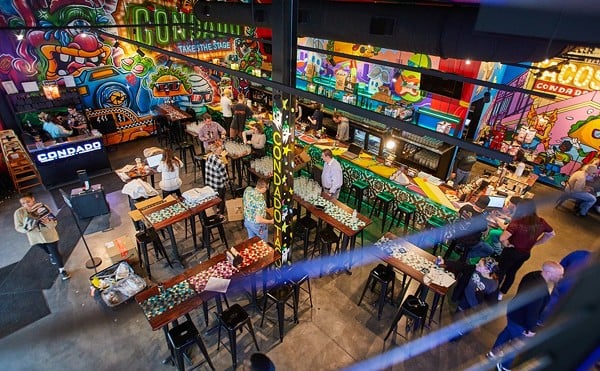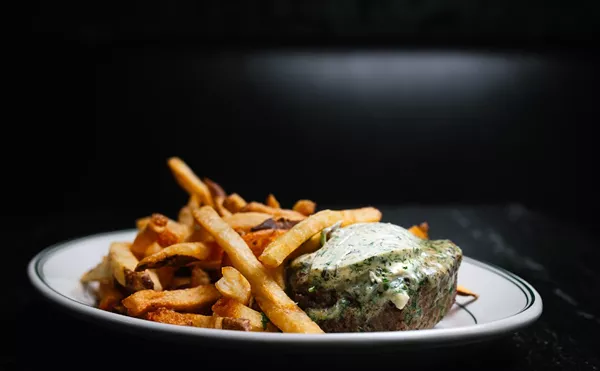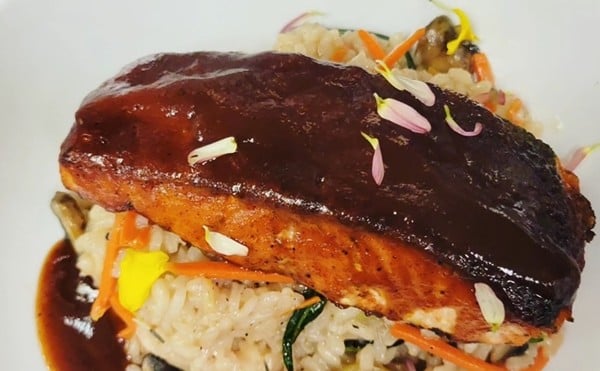The one-room interior, décorless, trappings-free and, on my visits, usually devoid of customers, isn't exactly sunny, either. To the right are the expected cluster of Formica-topped tables, which appear not to have been reset straight and perpendicular to one another in quite some time. To the left, refrigerated display cases consume a lot of what floor space there is between the door and the counter. Two, three or four cases may stand there on any given day, stocked with plastic jugs of soy milk and stacks of ready-to-go meals in see-through take-away containers. One day a case might be wedged uncomfortably close to the bathroom door; the next day that case is gone. Sometimes a case or two sit completely empty, maybe even unplugged. One time I walked in to find baked goods arrayed on an old dimestore candy rack.
Behind the counter (which accommodates the cash register and a short steam table that warms a few trays of lo mein) hangs the menu, scrawled on fluorescent squares of paper -- mostly in Chinese, with brief, virtually illegible English phrases below. The one or two people who man the nine-month-old operation speak with heavy Chinese accents and a limited English vocabulary. Ordering can devolve into a point-and-hope venture, especially in light of the fact that the provisions scarcely resemble anything a statesider is liable to encounter at a Chinese restaurant. There is no wonton soup, no beef with broccoli. The lo meins are the most recognizable dishes (and they're unremarkable, so don't bother). You may have seen the baked goods before as well, if you're familiar with dim sum: a half-dozen savories and sweets -- sesame or green-onion pancakes, steamed pork buns and dumplings, Chinese crullers and custard cups -- all of these distinctly mild (even the green onion) but damn tasty. (The custard cups, evidently made not with soy but with good ol' eggs and butter, I could eat all day.) There's not a grain of rice to be seen, anywhere, which might be enough to send many a first-timer into a panic.
After a second or third peek into the cases, though, things begin to make sense. Nearly every dish is founded on bite-size pieces of tofu -- some plain, some fried, some marinated in soy sauce until they bear the rich tone of beef jerky -- tossed with some combination of cilantro, peanuts, bok choy, carrots, celery and mushrooms. Each dish, whether consumed cold or heated up, registers clean and light on the tongue, soft and crunchy all at once, and delicious.
Which leaves the stranger-looking stuff, what Mark calls "Fear Factor fare." One take-away dish contains wavy slices of a substance that looks like raw bacon with a thin white cord of something running up the middle, tossed with cilantro and short pieces of white onion. That's smoked eel, and it's extremely tough to chew but has a great salty taste. The steam table often holds a pan of brown-shelled eggs, the size of chicken eggs but, judging by their hue, not. There's something almost prehistoric-looking about them. But they really are regular hard-boiled eggs, which have been steeped in soy sauce, their shells fragmented but left on so the sauce can soak through the cracks to the whites. The soy sauce really sours the egg whites, rendering them almost tart and bitter. On the other end of the spectrum, and the other end of the steam table, soy custard boasts about as much flavor as the plastic container it comes in -- until it's mixed with a few tablespoons of the provided ginger sauce (not too much, or it'll get soupy), and then suddenly it sings.
The only wall hangings at Soy Café are a few reprints of an old Time magazine story about healthy eating that touts isoflavones -- phytochemicals that purportedly accomplish anything from lowering cholesterol to warding off osteoporosis -- and mentions soy foods as an ideal source. Health nuts should certainly check out Soy Café, as should hard-core vegetarians and vegans, whose options can be limited in this town -- but most of all, the place beckons cheapskates. No dish costs more than three bucks here, and half of the dim sum items run less than a dollar each.
Similar impressions apply to two-year-old Gokul Snacks and Sweets, St. Louis' sole "Indian fast food" joint. Sharing a boxlike building with a check-cashing joint amid a fog of strip malls and gas stations in Overland, Gokul is exotic, healthy, vegan, cheap and very, very good. Unlike typical Indian restaurants, which are often laden with ornamentation and ethnic embellishments (sometimes even Christmas lights), the only visual cue toward Gokul's ancestry is the food. There's a utilitarian vibe to the place that makes it feel like an office kitchen, with its counter service, plastic baskets of utensils and napkins, the serve-yourself water cooler and compartmentalized foam trays for plates. At lunch, Gokul goes the way of many Indian eateries and offers an all-you-can-eat buffet. Dinner is à la carte and takeout is encouraged; in fact, the Indians even have a word, tiffin, that means "box dinner." Gokul's includes naan, two vegetable dishes, basmati rice, daal (lentils simmered with vegetables) and dessert.
Gokul's naan and basmati rice -- staples not just of the menu and buffet, but of Indian food in general -- are fantastic. The naan tastes, surprisingly and happily, like pizza crust: chewy and moist, almost to the point of being doughy, and simultaneously salty and sweet. The basmati rice, sticks of cinnamon jutting out of it like tree trunks, is perfectly soft and loose, studded with lovely, plump green peas. The menu is strictly meatless. (There's a sticker on the counter that reads, "Be kind to animals. Don't eat them.") Perhaps the highest compliment that can be paid here is that everything is so flavorful and hearty -- korma made with nine kinds of vegetables, crisp pakora (fried morsels of spinach and ground chickpeas), three dishes made with the tofu-like cheese paneer -- that the most diehard carnivore will be hard-pressed to miss the meat.
As at Soy Café, the contents of Gokul's refrigerator case prove most foreign. You wouldn't know it by all the spicy purées that comprise most Indian entrées, but traditional Indian fare includes loads of finger foods (often sold from streetside carts) and tons of sweets. Gokul's house-made mango ice cream, above all, is delectable: creamy like gelato, with a vibrant orange color and strong citrus taste.
To enjoy either of these restaurants, an adventurous palate helps -- but truly, the food is not as peculiar as you might think. If anything, the exploration happens not when eating something unfamiliar for the first time, but when driving somewhere that may not look at first sight like a worthwhile dining destination.





